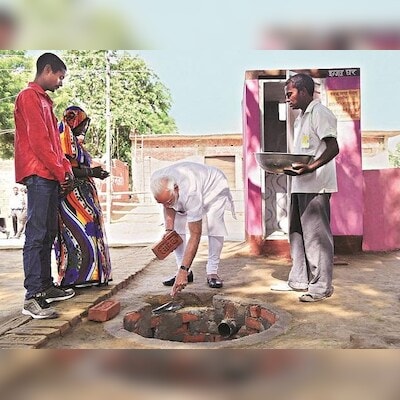Country-wide cleanliness campaign Swachh Bharat Mission (SBM), launched a decade back, contributed to preventing deaths of 60,000-70,000 infants and children under five annually from 2014 to 2020, according to a study in an international peer-reviewed scientific journal.
The research paper has been published in Scientific Reports, an open-access scientific journal published by British scientific journal Nature, and authored by researchers from the International Food Policy Research Institute, University of California and Ohio State University.
The researchers studied data from nationally representative surveys covering 35 states and union territories over 600 districts for a period of 20 years. The study looked at the link between an increase in access to toilet, built under the SBM, and drop in deaths among infants and children aged under five from 2000 to 2020.
Based on its findings, the paper noted that the SBM’s success in reducing infant mortality and mortality among children under five was evidence that “transformative sanitation programmes can deliver population health benefits in low-and middle-income countries”.
Prime Minister Narendra Modi had launched the SBM on October 2, 2014. One of the objectives of the campaign is to address open defecation in villages by providing access to toilets in all rural households. As of July 2024, almost 120 million (12 crore) toilets across rural and urban India had been built in the last nine years, according to a statement by Union Minister Hardeep Puri.
In a post on X, the PM said improved sanitation has become a “game-changer” for public health in India.
“Happy to see research highlighting the impact of efforts like the Swachh Bharat Mission. Access to proper toilets plays a crucial role in reducing infant and child mortality,” he said in his post, sharing a link to the research paper.
The study found that on average, improving district-level toilet access by 10 percentage points corresponded to a lowering of death rates in infants by 0.9 points and in those under five years of age by 1.1 points. Historically, having access to a toilet and deaths among children had been inversely related in India, the authors said.
They found that improving toilet coverage by 30 per cent and above in a district corresponded with substantial reductions in infant and children deaths. “In absolute numbers, this coefficient would scale to an estimated 60,000-70,000 infant lives annually,” the authors wrote.
The findings are in line with evidence from global and South Asian contexts, with multiple studies, that analysed population-level data collected via surveys, indicated that improved sanitation can potentially cut child mortality rates by 5-30 per cent, the researchers said.
Broader benefits of increased toilet access lead to improved women’s safety, financial savings from reduced medical expenses, and overall improvement in quality of life, the authors noted.
“However, despite these positive benefits, disparities in toilet adoption and usage persist due to caste and religion-based discriminatory practices,” they said.
The authors pointed out that “some studies indicate that coercive measures and discrimination implemented by local authorities to meet campaign targets have violated individuals’ rights, particularly affecting marginalised communities like manual scavengers and lower-caste individuals”.
Acknowledging the campaign’s progress, the United Nations Department of Economic and Social Affairs said that 500 million people across 6.3 lakh villages were benefited by 2019. Further, households in open defecation-free villages — each household equipped with a toilet — saved up to ~50,000 every year, with benefits exceeding costs by 4.7 times for members, it said.
Based on the study’s findings, government sources pointed out that the sanitation coverage under the UPA1 government was minimal, which increased dramatically under Modi-led National Democratic Alliance government’s tenure. Sources said open defecation has been eradicated, piped water supply coverage has increased from 16 per cent to 78 per cent and clean cooking gas connections given to more than 110 million households leading to better social and health outcomes.
Sources said IMR declined by three times from 2015 to 2020 compared to the 2000 to 2015 period and the gap between urban and rural IMR also shrunk at an accelerated rate. The paper revealed that the health benefits of SBM increased post the implementation of the Jal Jeevan Mission, sources said.
First Published: Sep 05 2024 | 9:04 PM IST
